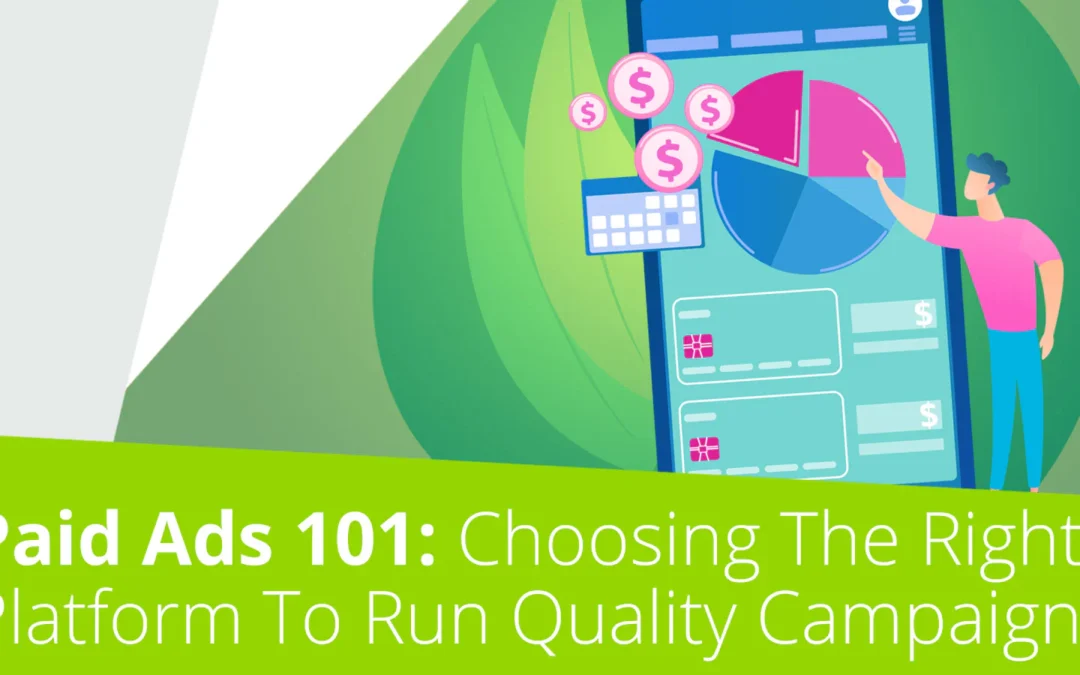Why Invest in Digital Marketing?
With the explosive growth in eCommerce over the course of the past few years due to COVID-19, it’s become even more critical for online companies to have a multi-channel presence, especially on popular paid ad platforms. However, as more buyers move online to shop, larger brands with stable revenue streams have followed suit by pushing dollars into paid search and social (in 2022 Google Ad Spend was $168 billion and Meta was $112 billion) increasing the competition in many verticals. As such, analyzing company to platform “fit” is essential to maximize budget and return on investment.
Popular Advertising Platforms
While Google Ads and Facebook/Instagram (AKA Meta) are the big players, Snapchat, TikTok, Pinterest, Microsoft Ads, and Yahoo are all worth consideration. Each one potentially has a unique benefit to offer your company. As a baseline, the following outlines what we consider the main benefits for paid platforms that naturally group together:
Google/Yahoo/Bing
- Drive highly relevant traffic based on search intent (i.e. keyword targeting)
- Easily assess product performance & competitive advantage opportunities (e.g. price)
- Own your branded search terms
Facebook/Instagram
- Reach highly targeted audiences (new & returning visitors)
- Build brand awareness
- Test a variety of ad formats & creative (video/image/product catalog)
TikTok/Snapchat/Pinterest
- Break through to very specific demographics
- Reach untapped audiences (i.e. may be here and not on other platforms)
- Utilize engaging creative and ad formats to build brand liking
Given how wide-ranging the benefits listed above are, it may be worthwhile for your company to test any number of paid ad platforms to see how they perform within your industry or target demographics. However, the decisions you need to make to form your eocmmerce marketing strategy shouldn’t be blind bets. You can make educated guesses that are more likely to result in successful ads by considering the following factors as they pertain to your own business.
Questions To Ask When Placing An Ad
The following are the categories we recommend considering about your business when deciding which of the different online advertising methods to use.
Check Your Business Model: What Is A Retailer And What Is DTC?
There are typically two main business models for eCommerce companies:
- Direct to Consumer – Sell only their own branded products (e.g. Native, Warby Parker)
- Retailer – Sell many different brands; sometimes private label (e.g. REI, Target)
(Manufacturers can also be included on the list, but they are more likely to sell to Amazon, wholesalers, or other third-party retailers, and thus rarely utilize D2C advertising.)
While retailers and D2C brands with an excellent product offering and/or competitive pricing–among other big selling points–may see success on the majority of paid platforms, many will benefit particularly more from one versus another based on their business model alone.
- For newer D2C companies, the exposure to targeted audiences on social platforms can be explosive, while a platform like Google Ads that leans heavily on brand recognition may never pick up traction for them.
- Example: One of Tadpull’s clients was struggling to gain traction on Google Ads due to high competition in their industry and difficulty capturing enough traffic, even with long-tail keywords that highlighted the product benefits. Through the use of targeted audiences and compelling Facebook ads demonstrating the product in action, new customer acquisition and revenue increased exponentially. The client more than doubled their sales and saw ROAS leap to over 1000%.
- For retailers that offer a variety of brands/products, Google Ads can often provide the highest ROI because of the ability to test a variety of keywords and hone in on the most successful areas of the business–like top-performing product categories or brands.
- Example: For a client that offers a wide variety of brands and products, Tadpull used margin and seasonality data to inform a series of Google Ad campaigns for them. By focusing on the most relevant products at any given time of year and year-round hot sellers that were most likely to get first-time customers to buy or one-time buyers to buy again resulted in a significant increase in return on ad spend without any sacrifice to revenue levels.
Consider Your Competition: Which Targeting Option Is Best For Achieving Brand Awareness?
If we look closer at the first client example that was given above, it’s highly apparent that the level of brand awareness for a company plays a large role in their success on certain paid platforms. Newer brands in competitive spaces have to focus on brand awareness and acquisition, pushing them towards social media platforms where target audiences can more easily be leveraged. Conversely, companies with higher brand awareness can rely more on the relevant keywords their customers are using to drive traffic to their site because users searching those terms are likely to recognize the brand name and trust that website to get them what they’re looking for.
Overall, much of paid advertising has the end goal of targeting the right users with the right messaging to hopefully coax out a conversion, but too many advertisers fail to consider that keeping their level of brand awareness top of mind helps them allocate their paid dollars to where they will be the most effective.
Customer Demographics: Why Is It Important To Identify Your Target Audience?
When it comes to spending precious marketing budget on social media ads, the costs tend to add up quickly. That’s why nailing down your target audience is paramount for anyone who advertises on these platforms.
While Facebook, Pinterest, and Instagram usage is more consistent across age groups, Snapchat and TikTok are largely used by a younger demographic. This is changing, however, as TikTok users are rapidly increase worldwide.

Source: Pew Research
Example: Curology is one example of a brand that has found huge success by advertising on Snapchat and TikTok. Their D2C customizable acne treatments are perfect for teenagers struggling to keep their breakouts in check using drugstore face washes, and they have more youthful, fresh branding that young people see advertised in an authentic way by hundreds of their favorite online influencers/creators. Not only do they have a great product/audience fit, but they also have capitalized on it by creating audience/channel fit as well.
If you know your target audience is primarily older, it may be a waste of time and money to invest testing on the newer platforms until there is wider adoption across age ranges. However, don’t write them off because you aren’t as familiar with these networks. They boast some of the highest success rates across the board for all paid ads for businesses that have the right audience and know how to create the right content to win that audience over.
When it comes to search engine ads, usage of Google, Bing, and Yahoo can vary across demographics. Comparing organic conversion rates across search engines by age is one strategy to assess if there’s any untapped potential worth exploring further with paid ads. You can easily find this data in Google Analytics with a few clicks under Acquisition > All Traffic > Source/Medium. Once there, set your table to the eCommerce view under the Explorer tab and set your secondary dimension to age to compare the demographic makeup and conversion rates for each organic source.

For this company, conversion rates and users are high for the 65+ age group, so Bing could be a good option to test if the target demographic falls into a higher age range.
Price: Does It Matter For Effective Meta Ads and Google Shopping Ads?
When it comes to product price, there can be significant differences in performance on paid platforms.
With search engine shopping feeds, if your product is comparable in benefits to competitors, but at a much higher price point, you may struggle to achieve return targets. While there’s far less comparison capability on social platforms, higher price points may still impact conversion rates, especially on places like TikTok or Snapchat, partially due to their younger usage demographic.
When users are scrolling through social media, they are in a low-intent form of internet browsing, so going from add to cart to checking out to confirmation with any high price point item sounds far too unreasonable. On the other hand, when consumers are in the education mode of online activity and are actively looking for information that will help them justify a more expensive purchase, paid search or paid featured referrals on relevant websites might be just what they need to finally go to your site and convert.
It’s always important to consider price points when analyzing results to see if there’s any evidence of its impact on performance, both overall and across different channels–especially for companies with a larger product catalog.
Creative Capabilities: How To Grab Customers’ Attention?
When it comes to ad formats, Google Ads and other search engine platforms largely utilize text ads and product feed ads (such as Google shopping ads), limiting the creative options to showcase products. Conversely, ads on social platforms obviously allow for a wider range of media options, from images and gifs to videos and user-generated content.
With a high-intent keyword search, a product feed is perfect to show a user exactly what they want to buy. On social platforms, creatively showcasing your product offering can inspire users to take action who didn’t even know they wanted the product in the first place.
BUT it does take time and assets to develop good creative that is optimized for performance on each platform. So before you dive in and start spending all your marketing budget on stock photos or outdated catalog shots, be sure to have a few solid assets and a creative testing framework in place.
Tip: Don’t always make assumptions about what you think will work best; try to utilize a variety of creative and use let the data determine what creative themes or formats are best to hone in on.

Creative that mixes static and dynamic visuals is a great way to capture attention as users are scrolling their feed without them needing to commit to watching a full video.
This doesn’t mean you need to have a high-tech creative team. Sometimes the most compelling ad creative can be a shaky iPhone video from a happy customer, as long as it’s genuine! But the big takeaway here is that maximizing your revenue potential does require a willingness to create and test unique assets that will grab the user’s attention in a competitive landscape.
Paid Ads In Summary
So, if you have a limited advertising budget, aren’t sure which paid platforms to start advertising on, want to improve your paid ad conversion rates, or whatever other concern you might have about the paid channel, hopefully everything we’ve outlined above provides some more context for you.
You’re one step closer to strategically determining what the best platforms are for your business to maximize the return on your advertising investment! If you still have questions about this channel or any of the platforms mentioned above, feel free to drop us a line here to set up some time to talk to our digital marketing experts or join our private community here and find a wide array of answers to your questions right away.
For more reading, check out any of our other blogs covering topics in the world of paid advertising:
Create Better Facebook Ads With This One Simple Product Insight
YouTube Ads: Simplifying Audiences and Ad Creation
A 6-Step Checklist To Protect Your Facebook Ad Account From iOS Change Effects
How To Turn Ad Spend Into 10x Profit By Building Audiences Based on CLV
Image: freepik

